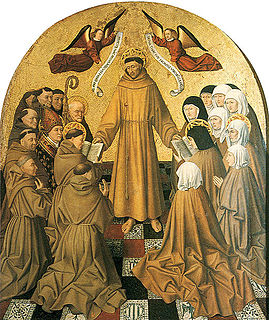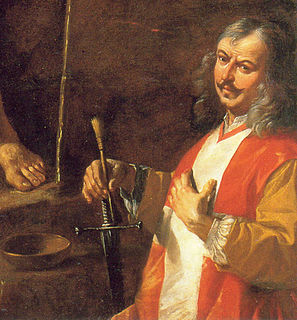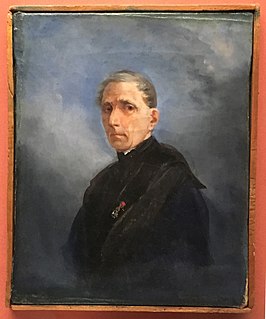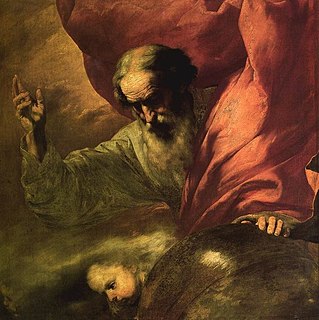
Colantonio was an Italian painter, who was the outstanding native figure in the art of Naples in the Early Renaissance.

Museo di Capodimonte is an art museum located in the Palace of Capodimonte, a grand Bourbon palazzo in Naples, Italy. The museum is the prime repository of Neapolitan painting and decorative art, with several important works from other Italian schools of painting, and some important ancient Roman sculptures. It is one of the largest museums in Italy. The museum was inaugurated in 1957.

Giovanni Battista Caracciolo (1578–1635) was an Italian artist and important Neapolitan follower of Caravaggio. He was a member of the murderous Cabal of Naples, with Belisario Corenzio and Giambattista Caracciolo, who were rumoured to have poisoned and disappeared their competition for painting contracts.

Mattia Preti was an Italian Baroque artist who worked in Italy and Malta. He was appointed a Member of the Order of Saint John.

Francesco de Mura was an Italian painter of the late-Baroque period, active mainly in Naples and Turin. His late work reflects the style of neoclassicism.

Salvatore Fergola was an Italian painter, mainly of landscapes or vedute in and around his native Naples. He is considered an exponent of the School of Posillipo.

Santa Maria della Verità is a church in rione Materdei, in the quartiere of Stella of Naples, Italy. The entry is located on Via San Agostino degli Scalzi, number 6.

The Palazzo Zevallos Stigliano is a Baroque palace located on Via Toledo number 185 in the quartiere San Ferdinando of central Naples, Italy. It is also called the Palazzo Zevallos or Palazzo Colonna di Stigliano, and since 2014 serves as a museum of artworks, mainly spanning the 17th through the early 20th centuries, sponsored by the Cultural Project of the bank Intesa Sanpaolo. This museum is linked to the Museum or Gallerie di Piazza Scala in Milan and the Museum at Palazzo Leoni Montanari in Vicenza, also owned by the Bank.

The Temples of Paestum is an 1824 painting by Antonie Sminck Pitloo. It shows two of the temples at Paestum, probably during an excavation.

Saint Sebastian is an oil on canvas painting by Italian artist Mattia Preti, created c. 1657. It represents Saint Sebastian, and is held in the National Museum of Capodimonte, in Naples.

Assumption of the Virgin with Saint John the Baptist and Saint Catherine of Alexandria is an oil on panel painting by Fra Bartolomeo, created c. 1516, commissioned by the church of Santa Maria in Castello in Prato. To the left of the Virgin's tomb is John the Baptist, whilst to the right is Catherine of Alexandria. It is now in the National Museum of Capodimonte in Naples.

Portrait of Maria Luisa of Parma is a portrait of Maria Luisa of Parma, wife of Charles IV of Spain, produced as a pendant painting to a portrait of her husband. Both works were long thought to be a copy after an autograph work by Francisco Goya, but they have now been definitively reattributed as autograph works by Goya himself, produced late in the 18th century. Goya was a court artist to the royal family, though most of his paintings of them are still in the Prado Museum. The two works were commissioned by the couple's daughter Maria Isabella of Spain. They were sent to Maria Isabella and they are both now in the National Museum of Capodimonte in Naples.

Madonna and Child with Donors or Sacred Conversation with Donors is a c. 1525 oil on panel painting by Palma Vecchio, now in the Museo nazionale di Capodimonte in Naples.

Judith and Holofernes is an oil on canvas painting by Italian artist Mattia Preti, datable to around 1653–1656. It is held at the Museo di Capodimonte, in Naples.

Penitent Magdalene is a c. 1550 oil on canvas painting by Titian, now in the Museo di Capodimonte in Naples.

Portrait of Cardinal Alessandro Farnese is a c. 1545-1546 oil on canvas three-quarter-length portrait of Alessandro Farnese the Younger (1520-1589) by Titian, now in the Museo nazionale di Capodimonte in Naples.

Madonna of Constantinople is a c. 1656 oil on canvas painting by Mattia Preti. It was the first of many works commissioned as ex-votos for freeing the city from the plague of 1656 – they all showed the Madonna with a selection of the city's patron saints, in this case Joseph, Januarius, Roch, Nicasius and Rosalia (centre). It now hangs in the Museo nazionale di Capodimonte in Naples.

Portrait of Pope Paul III with Camauro is a 1545 – 1546 oil on canvas painting by Titian, now in the Museo nazionale di Capodimonte in Naples.

The Earthly Trinity with Saints and God the Father are a pair of c.1626-c.1635 oil on canvas paintings by Jusepe de Ribera, both now in the Museo nazionale di Capodimonte in Naples. Along with the Holy Family, the main work shows Bruno of Cologne, Benedict of Nursia, Bernardino of Siena and Bonaventure.

Saint John the Baptist is a c.1653-1656 oil on canvas painting by Mattia Preti, now in the Museo nazionale di Capodimonte in Naples.




















